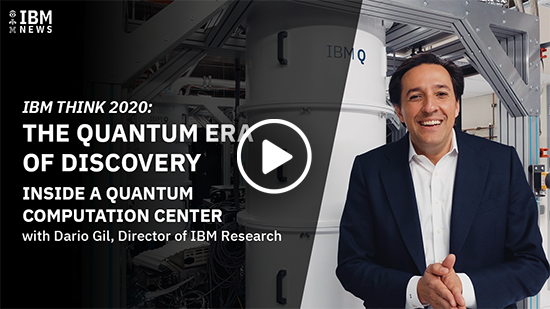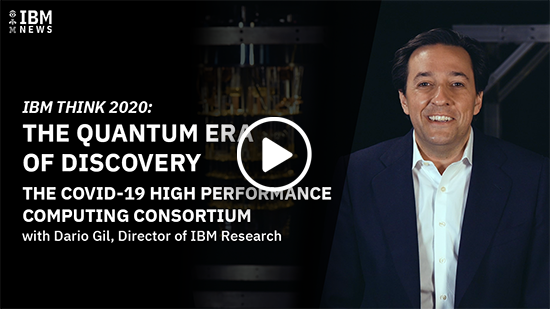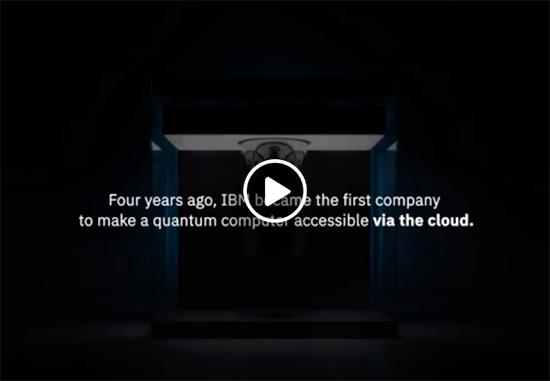THINK 2020 stories
Dario Gil: A New Quantum Era of Accelerated Discovery
By Larry Greenemeier
May 6, 2020

Explore an IBM quantum computing center with Director of IBM Research Dario Gil
Computing power and collaboration.
Exponential advances in computing, along with global collaboration, can help us confront world crises like the COVID-19 pandemic, as well as other big societal challenges, Dario Gil, Director of IBM Research, said Wednesday.
Gil, addressing the IBM Think Digital conference, noted that the emerging field of quantum computing will complement today’s supercomputers and other classical computers to accelerate scientific discovery and technical innovation.
→ Watch a replay of Dario Gil's complete Think Digital session
Collaboration is the key to success—not only among people, but also between the classical and quantum computing paradigms, Gil said, in a virtual presentation from IBM’s T.J. Watson Research Laboratory in Yorktown Heights, N.Y.
“In moments of crisis, it is particularly important that we all come together,” he said. “The world is being challenged with ever more complex problems to solve.”
IBM is lending its considerable resources to the fight as a founding member of the COVID-19 High Performance Computing Consortium. The group’s 30-plus members have aggregated more than 400 petaflops of computing power and 100,000 nodes to pursue a broad portfolio of projects to shed more light on the pandemic, understand the evolution of the virus and accelerate the pace at which researchers can develop antivirals and vaccines.

Watch Dario Gil discuss the COVID-19 HPC Consortium
As researchers struggle to determine how to deactivate the virus’s ability to function, early evidence in the battle against the coronavirus indicates that powerful computation is an important ally, Gil said. Supercomputers can be used to model and better understand the protein structure of the virus—an enemy no bigger than 100 nanometers—helping researchers explore different chemical compounds that could be used to fight it.
Toward the Qubit Paradigm
As researchers combat the pandemic using the bits of classical computing, another even more powerful paradigm is emerging—that of quantum bits, or qubits. “Moving forward, bits and qubits will be foundational computational paradigms with which we can tackle complex problems in the world,” Gil said.
Classical computers use binary circuits with on-off switches. Quantum computers, which deal in the realm of sub-atomic quantum physics, take advantage of certain “super powers” found in nature—superposition, inference and entanglement—to handle much more complex computations. These computations are represented by quantum circuits, which are the true measure of a quantum computer’s power.
“And the beautiful part of this is that we can have many classes of circuits to do different functions,” Gil said.
The uses go well beyond combatting viral pandemics. For example, one type of circuit might be designed to model financial risk, another to measure the energy of chemical compounds being considered in the development of new battery technology. Libraries of such quantum circuits are emerging that will be embedded in classical programs that combine the best of classical programming with the best of quantum power.
Celebrating a Quantum Anniversary
To emphasize the importance of circuits to quantum computing, IBM on Monday launched its Quantum Challenge. The challenge invites programmers to tackle four quantum computing exercises through May 8 that will improve their understanding of quantum circuits and put their skills to test. The event helps celebrate the fourth anniversary of the IBM Quantum Experience, which enables members of the public to access IBM’s fleet of quantum computers via the IBM cloud.

See a celebration of four years of quantum computing on the IBM Cloud
“We’re very fortunate,’’ Gil said, “that some of the best minds in the world are thinking really hard about what are the classes of circuits that give us a path to quantum advantage”—the point at which quantum computers perform operations significantly faster than classical computers.
He cited a seminal paper co-authored by T.J. Watson Laboratory researcher Sergey Bravyi that provided mathematical proof for the first time that these classes of circuits have proven advantages compared to classical ones.
Since May 2016, more than 180 billion quantum circuits have been executed on IBM quantum computers via the company’s cloud, which has provided quantum computing access to more than 230,000 users worldwide. IBM currently makes 18 different quantum systems available via the IBM Cloud. As part of his presentation, Gil provided a brief tour inside one of IBM Research’s quantum computation centers housing four of the company’s systems.
Gil’s presentation also included a description of the value of “quantum volume,” a measure of a quantum computer’s ability to lower error rates as its qubit count increases. He pointed out that the company has at least doubled the quantum volume of its offerings each year since 2016 and is committed to continuing that trend in the coming years.
Some of the world’s largest companies are also the most active users of IBM quantum computers, including Daimler AG, which is exploring quantum computing’s potential to develop better battery materials, and ExxonMobil, which is intent on modeling thermal reactions for use in petrochemical R&D. JP Morgan Chase, meantime, is using IBM quantum computers to create a methodology for pricing financial derivative contracts, known as options, as well as portfolios of options.
Gil closed his presentation with a key observation on the future of computing. “The most profound implication of what is happening today in computing,’’ he said, is the convergence of bits, qubits and neural network systems that form the foundation of artificial intelligence. This convergence will be orchestrated with the help of AI-assisted programming and a hybrid cloud architecture that masks the complexity of the underlying infrastructure, Gil said.
“The consequence of all of these coming together,’’ he said, “will be nothing short of a revolution in how science itself is practiced and the rate at which we can perform accelerated discovery and a whole new class of intelligent mission critical applications.”